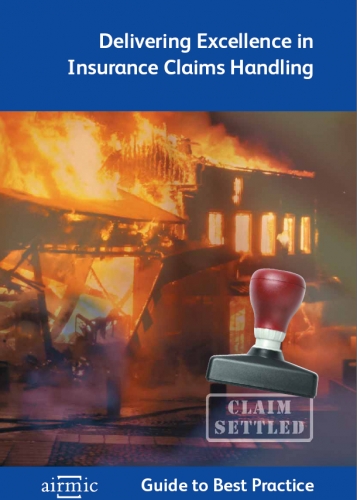Delivering Excellence in Insurance Claims Handling
1. Introduction
Claims handling service is the basis on which an insurance company is ultimately judged byclients and the key issue affecting the reputation of the insurer. The payment of legitimateclaims represents the delivery of the promise at the heart of the insurance contract. Indeed,for many insurance companies, excellent claims handling service is considered to be adifferentiator that distinguishes them from the competition.
Achieving excellence in claims handling should be a fundamental objective of any insurancecompany. This AIRMIC guide considers the components that should be in place to complywith best practice and the features of each component that need to be demonstrated.
There is a considerable amount of anecdotal and subjective evidence and opinion availableregarding the claims handling service provided by different insurance companies. This guideprovides the structure for an objective evaluation of claims handling capabilities.
The scope goes well beyond the KPIs that all claims handling operations have in place. The guide also considers the attributes of the Culture, Resources, Operations and Procedures(CROP) that need to be in place in order to deliver a best practice claims handling service.Within the CROP, operations represent the processes by which claims are handled, whilstculture, resources and procedures represent the framework that supports those processes.
Objective evaluation is necessary, so that the client can assess whether the claims handlingcapabilities of the insurer are aligned with the requirements of the insured. Insurancecompanies need to evaluate their claims handling function in an objective and structuredway, so that the capabilities can be presented to clients in a manner that enables theinsurance buyer to make comparisons.
Evaluation against the structure set out in this guide will also enable the insurance companyto identify the necessary improvements to claims handling capabilities, so that excellencemay be achieved and demonstrated.
This guide is substantially directed at the claims handling requirements of larger clients,although the principles also apply to more routine, higher volume claims handling operations.Likewise, these principles apply to the handling of disease claims, although this is a specialistarea. In general, however, it is the larger, more complex organisations that require greatersophistication from claims handling departments.
Large, complex claims do not arise very often. Therefore, large corporate clients requireobjective and detailed reassurance in advance that they will be handled in an efficient,effective and appropriate manner.
The ultimate test or objective is that claims are handled in a consistent, yet flexible and fair manner that is transparent, accurate and timely, as well as secure and compliant. This outcome will deliver the necessary features of partnership with clients and (asappropriate) insurance brokers.
This guide was developed during a series of workshops attended by AIRMIC members,together with insurance company, insurance broker and loss adjuster partners. AIRMIC isgrateful for their continuing enthusiasm and support, which has made possible the productionof this comprehensive guide to best practice in insurance claims handling.
- Fill out an application Our membership manager will assess your eligibility against our criteria.
- Complete your profileIf you are eligible for membership you will be asked to answer a few questions about yourself.
- PaymentYou can make payment online using a card or request an invoice.

